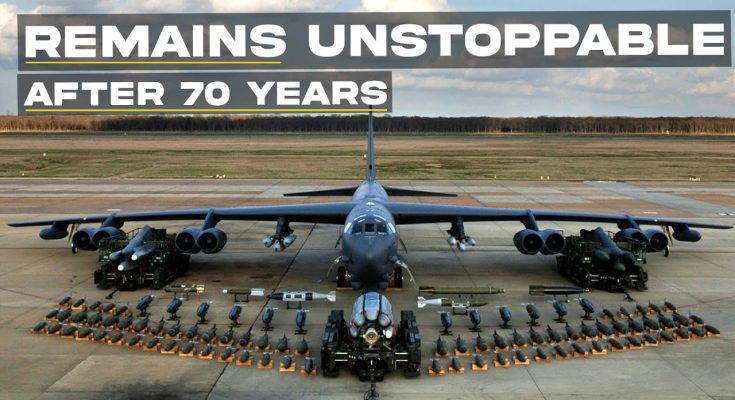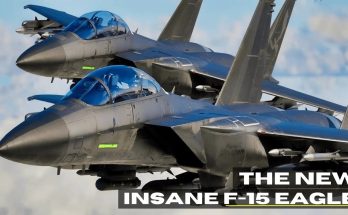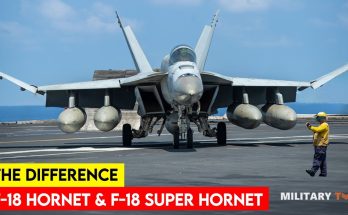The B-52 Stratofortress has remained a cornerstone of the United States Air Force for over 70 years, a testament to its remarkable versatility, adaptability, and sheer durability. Since its first flight in 1952, the B-52 has undergone numerous upgrades, evolving to meet changing military needs while maintaining the core capabilities that made it so effective in the first place. The bomber’s staying power is not due to one single factor, but rather a combination of several key elements that have kept it relevant in modern combat.
1. Unmatched Range and Payload Capacity
One of the most enduring features of the B-52 is its incredible range and payload capacity. The bomber can carry a wide array of bombs and missiles, including conventional and nuclear payloads, giving it significant strike capability. With a range of approximately 8,800 miles without refueling, it can strike anywhere on the globe. This long range allows it to be an effective deterrent and strategic asset, capable of reaching potential adversaries even when based far from the conflict zone. When refueled, its operational range is virtually limitless, providing flexibility in long-duration missions.
2. Adaptability to Modern Threats
While the B-52 was designed during the Cold War to carry out strategic bombing missions, it has consistently been upgraded to address contemporary needs. Over the decades, the aircraft has undergone multiple modifications to its avionics, weapons systems, and engines. It has been equipped to carry precision-guided munitions (PGMs) and has seen improvements in its radar and communication systems, making it suitable for a variety of modern combat scenarios.
The B-52’s capacity to integrate new technology means that, despite its age, it remains capable of carrying out missions in contested environments, such as deep-strike operations, where precision and survivability are crucial. Its ability to carry advanced munitions like the Joint Direct Attack Munition (JDAM), JASSM (Joint Air-to-Surface Standoff Missile), and CRS (Common Railgun System) ensures that it remains effective against modern, sophisticated targets.
3. Proven Durability and Low-Cost Maintenance
The B-52’s design emphasizes reliability and easy maintenance, which has allowed it to remain in service for so long. The aircraft was engineered with longevity in mind, and it’s not unusual for the B-52 to undergo a service life extension program that refreshes key components, ensuring that it can remain operational for decades. Its simple airframe and relatively straightforward systems make it easier and less expensive to maintain compared to more complex, modern bombers.
Moreover, the B-52’s robust construction allows it to endure significant battle damage and still complete its mission. This survivability makes it a valuable asset in high-risk environments, where other aircraft might be lost in action.
4. Strategic Deterrence and Psychological Impact
The B-52 is a symbol of strategic power. Its role in the nuclear triad—alongside submarines and land-based missile silos—continues to provide a critical deterrent to adversaries, especially in a world where nuclear threats remain a significant concern. The presence of B-52s in the skies serves as a reminder of the U.S. military’s ability to project force globally.
Additionally, the B-52’s sheer size, ability to deliver heavy payloads, and iconic appearance have an outsized psychological impact. It serves as a reminder of American military might, both to allies and potential adversaries.
5. Cost-Effectiveness
Despite its age, the B-52 remains relatively inexpensive to operate compared to newer, more specialized bombers. Its long service life, combined with a relatively low cost of maintenance, allows the U.S. Air Force to keep it in service without breaking the bank. This cost-effectiveness makes it an attractive option for continued use, even as newer technologies emerge.
Conclusion
The B-52 Stratofortress has endured for over 70 years because it is a versatile, durable, and effective platform that has evolved to meet modern military needs. Its combination of range, payload capacity, adaptability, and low-cost maintenance ensures that it remains an essential tool for the U.S. military’s strategic arsenal. In an era where defense budgets are often constrained and new aircraft can cost billions, the B-52’s ability to evolve while remaining cost-effective ensures its place as an indispensable part of the U.S. Air Force for the foreseeable future.



